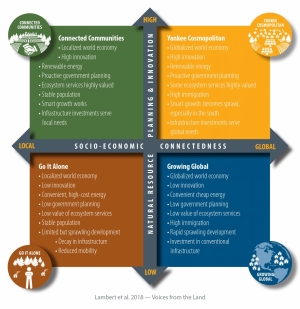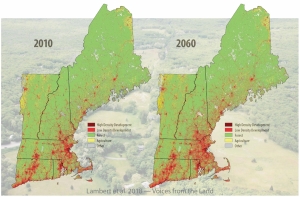You are here
Voices from the Land
 Voices from the Land: Listening to New Englanders' Views of the Future, released in September 2018 by the Harvard Forest and the Science Policy Exchange, with support from Highstead and the National Science Foundation, provides a stakeholder-driven approach for addressing the important question: What does the future hold for the New England landscape?
Voices from the Land: Listening to New Englanders' Views of the Future, released in September 2018 by the Harvard Forest and the Science Policy Exchange, with support from Highstead and the National Science Foundation, provides a stakeholder-driven approach for addressing the important question: What does the future hold for the New England landscape?
Envisioning the Future Together
The Voices report represents a collaborative effort of engagement professionals and research scientists that is only possible due to the willingness of New Englanders to share their time and expertise with the project team.
Kathy Fallon Lambert led the engagement team of Marissa McBride, Emily Huff, Kathleen Theoharides, Patrick Field, and Jonathan Thompson in working with New Englanders to develop future scenarios that capture their ideas about the future of the region.
Harvard Forest senior ecologist Jonathan Thompson then led the science team of Joshua Plisinski, Matthew Duveneck, and Luca Morreale in simulating and mapping the scenarios as land use changes through the year 2060. You can explore the scenario maps with the NELF Explorer.
Local Views of the Land
The Voices report, by lead author Kathy Fallon Lambert, summarizes the perspectives of 169 New Englanders regarding future land development, conservation, agriculture, and timber harvest. Through a series of interviews and workshops led by Lambert, New Englanders contributed their views about how the region might change.
Learn more about the interview process in a 2017 paper in Ecology and Society by lead author Marissa McBride.
Participants showed a powerful attachment to the New England landscape and urgent concerns about whether current conservation and land-use planning activities are enough to keep pace with increasing development pressure, forest fragmentation, extreme weather, and changing economic pressures on landowners.
Where Stakeholder Voices Converged
Key findings in the report include:
- Many participants expressed similar views about what a positive future for New England could look like.
- Compounding pressures that are changing the land at accelerating rates and in less predictable ways pose new challenges for landowners and land managers.
- New Englanders view environmental, social, and economic issues as interconnected forces that together shape the future of the land, as exhibited by the two drivers of change that define 4 future scenarios (described in the report).
- Many believe that new land-use planning approaches, land conservation partnerships, and resources are needed to better adapt to change.
Voices as a Foundation for Research and Action
The Voices publication does not end with summarizing the key themes that emerged in interviews and workshops.
Stakeholder narratives formed the basis for four scenarios of future land use in New England, which are also described in detail in the report. These scenarios provided parameters for a complex computer model -- developed at the Harvard Forest in senior ecologist Jonathan Thompson's lab -- analyzing 4 possible outcomes for land cover in New England through 2060.
In addition to describing the scenarios, the new report outlines the conservation and research applications they provide.
Resources
A limited number of print copies are available. To request print copies, send your mailing address with the subject "Voices from the Land Print Copy Request" to lucylee@fas.harvard.edu.
To explore and download figures from the report, click each image.
New England land cover in 2010 and 2060 based on recent trends. By 2060 an additional 1.2 million acres of forestland will be lost if recent trends continue. Recent trends were determined by an analysis of twenty years of Landsat satellite images documenting changes in New England land use from 1990 to 2010.

The scenario matrix illustrating the four quadrants created by the two drivers, "Socio-economic connectedness" and "Natural resource planning & innovation," along with the characteristics of the four scenarios.
Suggested citation for this report:
What's Next?
This report is the first of several products and associated events:
- Scenarios, Services, and Society RCN Final Workshop (November 14 and 15, 2018, in Amherst MA - as part of the 2018 RCP Network Gathering)
Registered attendees joined capstone workshops on the New England land-use scenarios and their applications for conservation and research. Attendees were able to try out a beta version of a scenarios-based interactive online mapping tool prototype and help shape its final phase of development. - New England Landscape Futures Explorer tool
This interactive web-tool, released early in 2019 and developed with support from the National Science Foundation and Highstead, makes scenarios data and mapping products available and accessible to conservation professionals and the public. - Online scenario explorer tool and planning workshops (throughout 2019)
These interactive workshops will be open to stakeholder participants from the scenario-generation process and others interested in using the scenarios for conservation applications and research. At least 4 workshops will be offered. Details will be announced here as workshops are scheduled. - Changes to the Land: New England (expected May-June 2020)
A regional follow-up to a Massachusetts-based Changes to the Land report published in 2013, this publication will use maps and data to 1) provide a detailed snapshot of the modern New England landscape and the interacting ecological and human forces that have shaped it, 2) illustrate drivers of current and future change, and 3) use scenarios to explore the changes we can expect on the landscape in the coming half-century.


